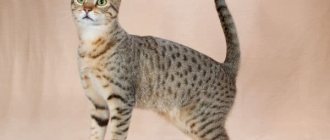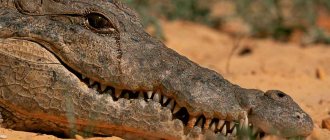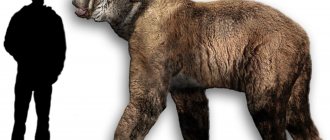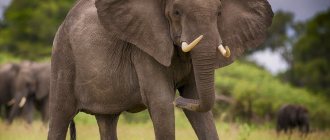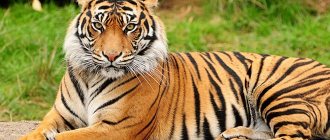On the first day of spring, March 1, Cat Day is celebrated in Russia. According to some reports, the holiday was first organized in 2004 by the Moscow Cat Museum and the newspaper “Cat and Dog”. Interestingly, many countries also have national days to honor these animals. For example, in the USA it is October 29, in Poland – February 17, in Japan – February 22. And the basis for all national Cat Days was World Cat Day, celebrated on August 8th.
The cat family belongs to the class of mammals, the order of carnivores. All cats - from the small domestic cat to the large Amur tiger - are excellent hunters. The first cat-like mammals appeared about 60 million years ago, during the Eocene era. The evolution of true cats began about 40 million years ago. Modern felines are divided by genera into cheetahs, caracals, catopumas, tiger cats, servals, lynxes, marbled cats, Asian cats, golden cats, pumas, clouded leopards, panthers and just cats, which also includes the domestic cat, a subspecies of the forest cat. The fauna of Russia includes such felines as the Far Eastern forest cat, manul, jungle cat, forest cat, common lynx, Amur tiger, Far Eastern and Central Asian leopards, snow leopard and caracal.
The Russian Geographical Society is engaged in the conservation and study of rare feline species: the Amur tiger, the Far Eastern leopard, the snow leopard, the manul and the lynx.
Amur tiger
The Amur tiger is one of the largest land predators on our planet: the body length of males reaches 220 cm, weight - 185 kg. It is also one of the smallest subspecies of tiger - about 550 individuals live in the wild. 95% of the entire population lives in the Russian Far East and 5% in China. In Russia, the Amur tiger population is concentrated in the Primorsky and Khabarovsk Territories, the Amur Region and the Jewish Autonomous Region. 20% of the Russian habitat is in nature reserves, national parks and sanctuaries - a special protection regime has been established here and animals can feel safe. The remaining 80% are hunting grounds, where the Amur tiger has to compete with hunters for ungulates. The Amur tiger is listed in the Red Book of the International Union for Conservation of Nature (IUCN) and in the Red Book of the Russian Federation.
svetlana-sutyrina-amurskiy-tigr-2.jpg
Amur tiger. Photo: Svetlana Sutyrina
Interesting Facts
- The Amur tiger lives in low mountains, preferring river valleys and wide valleys between ridges, covered with forest.
- The tiger is omnivorous. He can eat both a frog and a bear. However, in the wild, Amur tigers prefer to feed on ungulates: deer, wild boar, roe deer and musk deer. For adequate nutrition, one tiger needs about 50–70 ungulates per year. At the same time, a tiger can eat up to 35 kg of meat in one go.
- A tiger can jump 5 m upward and 10 m long.
- A tiger's tail is a kind of indicator of its mood. When the tiger is calm, the base of its tail is lowered and the end is curved smoothly upward.
- The span of a tiger's whiskers roughly corresponds to the width of its body. Thanks to its whiskers, the predator is able to determine the nature of the surface, temperature, and wind direction. The animal is guided by its whiskers when moving in the dark.
Since 2010, the Russian Geographical Society has supported the Amur Tiger project. Its goal is to study the state of the Amur tiger population and develop scientific foundations for the conservation of the animal. In 2013, on the initiative of the President of the Russian Federation, Chairman of the Board of Trustees of the Russian Geographical Society, Vladimir Putin, the Society became the founder of an autonomous non-profit organization. Its activities focus on the fight against poaching, scientific analysis of the state of the Amur tiger population and ecosystems in the animal’s range, and the organization of educational and educational events.
Far Eastern leopard
The Far Eastern leopard is the rarest subspecies of the cat family on Earth. Currently on the verge of complete extinction. According to various estimates, about 80 individuals live in natural conditions. At the same time, most of the population lives in Russia in the Primorsky Territory and a smaller part lives in China. About 70% of the rare predator's habitat is protected by the Land of the Leopard National Park. In the 20th century, the species was listed in the IUCN Red Book, the Russian Red Book, the IUCN Red List and in Appendix I to the Convention on International Trade in Endangered Species of Wild Fauna and Flora (CITES).
Clouded leopard
The territory of the clouded leopard is the forests of Southeast Asia. Its build and thick tail make it extremely agile. With a weight of 23 kilograms and relatively large fangs, this cat is therefore a dangerous predator. He catches his prey by waiting for hours in a tree for an opportune moment to attack.
dalnevostochnyy_leopard_rgo-dalnevostochnyy-leopard-foto_valeriy_maleev.jpg
Far Eastern leopard. Photo: Valery Maleev
Interesting Facts
- The leopard feeds mainly on ungulates, as well as raccoon dogs, badgers, and hares. The leopard does not attack livestock, but can hunt dogs.
- Typical habitats for the Far Eastern leopard are coniferous-deciduous forests of the Manchurian type. The predator prefers territories with rugged terrain, steep slopes of hills, rocky outcrops and watersheds.
- The length of males reaches 136 cm. The weight of a male reaches 60 kg.
- Each leopard has its own unique spotted pattern, thanks to which scientists distinguish these predators.
- The Far Eastern leopard is the most peaceful subspecies of leopard. Throughout history, not a single case of an Far Eastern leopard attacking a person has been recorded. Out of curiosity, young individuals can follow the tracks of a person - if they meet by chance, they do not rush to run away, but study the person with interest, without showing signs of aggression.
Cheetah
Despite the height at the withers, reaching 92 cm, and the weight of 65 kg, zoologists classify the cheetah as a subfamily of small cats. This is due to the peculiarities of the skeleton - the mammal has long thin limbs, a compact skull and an extremely flexible spine. This structure allows the animal to reach speeds of up to 120 km/h. In hunting, it is also assisted by a long tail, which serves as a balancer and helps to quickly change the direction of movement.
In appearance, the sprinter of the fauna world resembles an elegant dog of the Russian greyhound breed. Like dogs, giant cats do not retract their claws, cannot climb trees, do not ambush hunt, and do not tend to eat carrion. The sounds they make resemble abrupt yelps. Unlike most of their relatives, cheetahs quickly get used to humans. In Iran, India and Kievan Rus, tamed animals often helped people hunt.
dalnevostochnyy_leopard_-_mihail_kolesnikov.jpg
Far Eastern leopard.
Photo: Mikhail Kolesnikov Since 2011, the Russian Geographical Society has supported the Far Eastern Leopard project. Its goal is to study the state of predator populations, as well as develop the infrastructure of specially protected natural areas within its range.
In order to preserve the unique natural territories of Russia where the Far Eastern leopard lives, and thus save this subspecies, an autonomous non-profit organization “Far Eastern Leopards” was established in 2011. It cooperates with the Leopardovy Nature Reserve, the Kedrovaya Pad Nature Reserve and the Land of the Leopard National Park, created in 2012.
Irbis, or snow leopard
The snow leopard, or snow leopard, is the only species of the snow leopard genus and the only large representative of the cat family that lives in the highlands of Central Asia. The habitat of the snow leopard lies in the upper and middle zone of the mountains of Central and Central Asia (Himalayas) and Southern Siberia. This range includes the territories of Russia, Afghanistan, Burma, Bhutan, India, Kazakhstan, China, Kyrgyzstan, Mongolia, Nepal, Pakistan, Tajikistan and Uzbekistan. The species is endangered. According to various estimates, about 7 thousand snow leopards live in the wild, while in Russia there are only 150–200 individuals. In the Red Book of the Russian Federation, the snow leopard belongs to category I. This predator is also listed in the Red List of the International Union for Conservation of Nature and in Appendix I of the Convention on International Trade in Endangered Species of Wild Fauna and Flora (CITES). In 2011, the state nature reserve of federal significance “Pozarym” was created, on the territory of which the reintroduction of young snow leopards is carried out.
British Shorthair
This breed of cats reaches 7-8 kg, have a friendly character, although it is believed that the British are arrogant, independent and “walking on their own” cats.
They have high intelligence, playfulness, and, of course, independence; they will not tolerate bad treatment. The average price of a British shorthair cat is about 12,000 rubles.
irbis-pixabaycom.jpg
Snow leopard. Photo from pixabay.com
Interesting Facts
- A male snow leopard reaches a length of 125 cm and weighs up to 45 kg.
- Snow leopards make dens in caves or rock crevices. Each snow leopard lives within the boundaries of a strictly defined individual territory. However, it does not aggressively defend its territory from other members of its species.
- The basis of the snow leopard's diet is mountain goats, rams, roe deer, wild boars, marmots, hares and snowcocks. Snow leopards consume plant food - green parts of plants and grass - in addition to their meat diet only in the summer.
- The snow leopard is able to cope with prey three times its mass. Usually he hunts alone, crawling up to the animal from behind shelters. When there are several tens of meters left to the potential prey, the snow leopard jumps out of its cover and quickly overtakes it with jumps of 6–7 meters.
- Snow leopards are very playful and love to wallow in the snow. They often slide down a steep hill on their back, and at the bottom quickly turn over and fall into a snowdrift on all four paws. After games or hunting, they settle down to bask in the sun.
Jaguar
Jaguars are strong swimmers. (Image credit: James Keith/Getty Images)
Jaguars (Panthera onca) are the largest felines in the Americas. They live in North, Central and South America, but most live in the Amazon rainforest, according to the IUCN. Jaguars can occasionally be seen near the Mexican border in the United States, but for the most part, humans have driven the big cats out of their historical northern range, which included Arizona and New Mexico. ()
Jaguars grow from 1.5 to 1.8 meters in length without a tail and up to 2.7 meters with a tail. According to Panthera, they can weigh almost 158 kg. Jaguars hunt a wide variety of animals from their range, including deer, monkeys and fish. ()
irbis-mihail_semenov.jpg
Snow leopard.
Photo: Mikhail Semenov In 2010, the Russian Geographical Society supported the grant project “In the Footsteps of the Snow Leopard.” Its goal is to study the state of the snow leopard population, its numbers and age-sex structure, as well as key habitats. These data will help solve the problem of optimizing the territorial protection of this species, as well as the ecosystems of Southern Siberia as a whole. In 2012, the project “In the Footsteps of the Snow Leopard” grew into a full-scale project “Wild Cats of Southern Siberia” to study and preserve rare species of cats in the south of Siberia - snow leopard, manula and lynx.
Manul
The Pallas's cat is a predatory mammal of the cat family, one of the least studied wild cats in the world. Pallas's cat is widespread in Central and Middle Asia, from Southern Transcaucasia and Western Iran to Transbaikalia, Mongolia and Northwestern China. Within Russia, Pallas's cat is found in the Chita region, Buryatia, Tuva and Altai. Included in the Red Books of the Russian Federation, the Trans-Baikal Territory, as well as the republics of Tyva and Buryatia. Manuls can be seen in the Sayano-Shushensky, Khakassky, Daursky nature reserves. The exact number of the species is unknown due to the secretive behavior of the Pallas's cat and the patchy nature of its distribution. Pallas's cat is listed in the Red Book of the Russian Federation, the IUCN Red List and Appendix II of the CITES Convention.
Siberian cat
The exceptionally beautiful Siberian cat is already 1000 years old. Russian felinologists (this is the name given to specialists who study the anatomy, physiology and habits of domestic cats) believe that the first “Siberians” were brought to Russia by merchants from Central Asia. Over time, harsh climatic conditions forced cats to acquire long hair. Just like the Chartreuse, the Siberian cat grows up to 5 years. An adult male weighs 4–6 kg. The height of the male is 40 cm, the female is 30 cm.
View this post on Instagram
A post shared by Victor Ray (@v1cr4v)
The Russian breed standard was recognized by the World Cat Federation in 1991. Since the 2000s, the Siberian cat has been considered the national breed of Russia.
manul2-evgeniy_mazurin.jpg
Manul. Photo: Evgeny Mazurin
Interesting Facts
- The Pallas cat looks like a typical small cat, similar in size to its domesticated relatives. The body length of males reaches 65 cm, weight can reach up to 6 kg.
- The animal does not know how to run fast, so it escapes from enemies by resorting to hiding, in which protective coloring helps it, or by hiding in a shelter - a narrow niche, hole, on a rock, on a tree.
- Pallas's cat feeds mainly on pikas and rodents: gerbils, voles, ground squirrels, hamsters, as well as partridges and chukars. Sometimes it catches young marmots, tolai hares, and small birds. The Pallas's cat obtains food mainly from ambush, lying in wait for a long time for the victim at the entrance to the hole. The main trump cards of predators are long, motionless hiding and lightning-fast throw.
- It is difficult for Pallas' cats to live in places with high snow cover. For a cat, even 20 cm of snow is already a disaster.
- The Pallas cat received its second name - the Pallas cat - in honor of the Russian and German naturalist Peter Simon Pallas, who first gave a scientific description of this species on the coast of the Caspian Sea in the 18th century.
Liger
Liger
There is a cat even bigger than the tiger. This is a "liger" - a giant lion with blurry stripes, resulting from crossing a tiger with a lioness. Scientists believe that the size of the hybrid is the result of the absence of genes that limit growth. Ligers grow to a length of more than 3.5 meters and weigh more than 400 kg . There are about 25 ligers on the planet. The behavioral traits of this animal appear as a combination of the habits of both parent species.
Thus, fifth place in the list of the TOP 5 largest cats in the world is occupied by the puma, which is a member of the genus Puma. The highest positions are occupied by cats that belong to the genus Panthera - leopard, jaguar, lion and tiger, which tops this ranking. The cat, even larger in size than a tiger, is a liger - a hybrid obtained by crossing a lion and a tigress.
If you find an error, please select a piece of text and press Ctrl+Enter.
manul-evgeniy-mazurin.jpg
Manul. Photo: Evgeny Mazurin
Lynx
Lynx is a genus of predatory mammals of the cat family, closest to the genus of cats. It lives in Russia, Scandinavia, Finland, some areas of Poland and the Czech Republic, as well as in Spain. In Russia it is found in dense, overmature coniferous forests from the western borders up to Kamchatka and Sakhalin. The lynx is included in Appendix I of the Convention on International Trade in Endangered Species of Wild Fauna and Flora (CITES) and in the list of endangered animals of the international Berne Convention. This rare, endangered species is also present in the Red Data Books of Belarus, Kazakhstan and 17 constituent entities of the Russian Federation.
Leopard
The leopard is also sometimes called the panther. Which name is used depends mainly on the region where it is found. In Africa this animal is called a leopard, and in Asia it is called a panther. The leopard has excellent eyesight, which allows it to hunt both day and night, in addition, its sense of smell and hearing are impressive. However, he hunts mainly at dusk and at night, because this way he is less visible to his prey. Among the animals he hunts are antelope, deer, pigs, goats and baboons.
rys_-_dmitriy_vahrushev.jpg
Lynx. Photo: Dmitry Vakhrushev
Interesting Facts
- The body length of a male lynx reaches 106 cm, weight – up to 30 kg.
- The lynx is very dexterous: it not only climbs trees and rocks well, but also runs quickly, makes large jumps up to 3.5–4 m, makes long treks, and swims well.
- The objects of lynx hunting are hares, roe deer, musk deer, chamois, aurochs, various birds, rodents, as well as young deer, wild boar, and elk. Hunting through deep snow and crust, the lynx defeats large adult animals.
- The lynx does not touch humans; only a few facts are known that indicate how a wounded lynx attacked people. In her usual state, when meeting a person in the forest, she tries to hide and not show her presence.
- Thanks to the tufts on its ears, the lynx has incredible hearing; it can hear a person’s steps several kilometers away.
Lion is the king of the animals
A dangerous predator who is not alien to nobility and greatness. The weight of a lion can reach 250 kg, and the height at the withers is about 123 cm. The length of the body ranges from 170 to 250 cm. In its structure, a lion is very similar to a tiger. Color varies from dark brown to sand. Lions are the only ones from the family of big wild cats to have a small tassel at the tip of their tail. Females differ from males not only in their smaller size, but also in the absence of a mane, the main decoration of a lion. It is not for nothing that he is called the gentleman of the world of predators. His proud, majestic demeanor and noble warning of the start of the hunt with a royal roar make one admire and admire this animal from afar.
They are the only ones from the family of big wild cats that do not live alone, but in peculiar families - prides. Typically, a pride includes females, cubs up to three years old and several males. The pride is led by a leader, an experienced and strong male. During the hunt, females usually serve as beaters, while males wait in ambush. It is almost impossible for an outside lion to get into the pride; an exception is made only in the case of a female vacancy. As a rule, the number of prides is the same and is regulated, obviously, depending on the food supply.
The lion's extant range is in Africa, with a small population in India.
rys-dmitriy-vahrushev.jpg
Lynx.
Photo: Dmitry Vakhrushev In 2012, the Russian Geographical Society grant project “In the Footsteps of the Snow Leopard” grew into a full-scale project “Wild Cats of Southern Siberia” for the study and conservation of rare cat species of southern Siberia - snow leopard (irbis), manula and lynx. The project is aimed at increasing the effectiveness of environmental protection measures in specially protected natural areas of Southern Siberia - these are the Khakass and Sayano-Shushensky nature reserves, the Ubsunurskaya Kotlovina state nature reserve and the Pozarym state nature reserve of federal significance. Among the objectives of the project are studying nutrition, monitoring the food supply and conducting a zoological and veterinary examination of natural populations of wild cats, as well as increasing the level of public knowledge about the need and importance of preserving rare species of animals.
Author: Anna Sokolova
Ragdoll
Ragdoll cats, although different in size from ordinary pets, cannot be considered true giants.
The largest among them are males, and even then not always. Ragdolls weigh up to nine kilograms with a maximum height of one meter.
Such cats are also called rag dolls. Their ancestors gave them tireless ardor, kindness, a pretty appearance and an absolute lack of aggression. Ragdoll kittens cost from 10,000 rubles. up to 40,000.
The biggest cat in history
For decades, Himmy from Australia was considered the largest cat in the world. In 1986, at the time of his death, Himmi weighed 21.3 kg.
Guinness World Records soon eliminated the weight category, focusing on length and height. The record holder for length was a Maine Coon from Italy - Barivel. On May 22, 2022, the length of the record holder was 120 cm. However, Maine Coons grow up to 4 years old. In 2022, Barivel will turn 5 years old, which means the record holder has had time to grow up. Himmi was inferior in length to Barivelu and reached only 96 cm.
View this post on Instagram
A post shared by Victor Ray (@v1cr4v)
In the photo: Barivel is a record-breaking cat for size.

